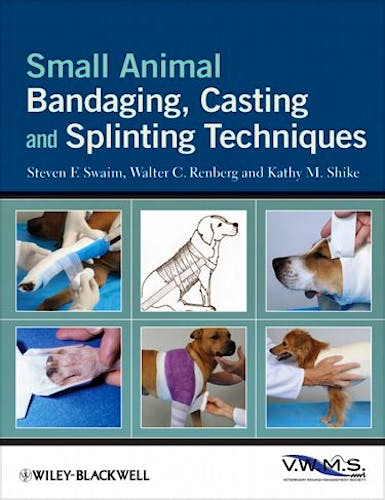

No hay productos en el carrito



Small Animal Bandaging, Casting, and Splinting Techniques
Swaim, S. — Remberg, W. — Shike, K.
1ª Edición Enero 2011
Inglés
Tapa blanda
114 pags
1000 gr
19 x 25 x 1 cm
ISBN 9780813819624
Editorial WILEY
LIBRO IMPRESO
-5%
66,01 €62,71 €IVA incluido
63,47 €60,30 €IVA no incluido
Recíbelo en un plazo de
2 - 3 semanas
LIBRO ELECTRÓNICO
-5%
54,75 €52,01 €IVA incluido
52,64 €50,01 €IVA no incluido
Acceso On Line
Inmediato
Description
Small Animal Bandaging, Casting, and Splinting Techniques is a well-illustrated how-to manual covering common bandaging methods used to support and manage both soft tissue and orthopedic conditions in small animal patients. This highly practical book offers step-by-step procedures with accompanying photographs to aid in the secure and effective application of bandages, casts, and splints, with coverage encompassing indications, aftercare, advantages, and potential complications for each technique. Small Animal Bandaging, Casting, and Splinting Techniques is an indispensable guide for busy veterinary technicians and nurses, as well as veterinarians and veterinary students.
Table of contents
- Mission Statement.
- Foreword.
- Preface.
- Acknowledgments.
Chapter 1 – Basics of Bandaging, Casting, and Splinting.
- Bandaging.
- Purpose and functions of a bandage.
- Components of a bandage.
- Primary-contact layer.
- Highly absorptive dressings.
- Gauze dressings.
- Hypertonic saline dressings.
- Calcium alginate dressings.
- Copolymer starch dressings.
- Moisture-retentive dressings.
- Polyurethane foam dressings.
- Polyurethane film dressings.
- Hydrogel dressings.
- Hydrocolloid dressings.
- Nonadherent semiocclusive dressings.
- Antimicrobial dressings.
- Extracellular matrix bioscaffold dressings.
- Secondary-intermediate layer.
- Tertiary-outer layer.
- Special considerations in bandaging, casting, and splinting.
- Frequency of changes.
- Security.
- Pressure relief.
- Joint immobilization.
- Maceration and excoriation.
- Need for sedation or anesthesia during bandage change.
- Casts and splints.
- General information.
- Purposes and functions of casts and splints.
- Materials.
- Splint rods.
- Commercial splints.
- Plastic splinting material.
- Stockinette.
- Casting tapes.
Chapter 2 – Head and Ear Bandages.
- Emergency ear bandage.
- Indications.
- Technique.
- Aftercare.
- Advantages and complications.
- Basic head and ear bandage.
- Indications.
- Technique.
- Aftercare.
- Advantages and complications.
- Thoracic, abdominal bandages.
- Circumferential thoracic, abdominal bandage.
- Indications.
- Technique.
- Aftercare.
- Advantages and complications.
- Windowed thoracic, abdominal bandage.
- Indications.
- Technique.
- Aftercare.
- Advantages and complications.
- Thoracic, abdominal tie-over bandage.
- Indications.
- Technique.
- Aftercare.
- Advantages and complications.
- Pelvic bandages.
- Circumferential pelvic bandage.
- Indications.
- Technique.
- Aftercare.
- Advantages and complications.
- Windowed pelvic bandage.
- Indications.
- Technique.
- Aftercare.
- Advantages and complications.
- Pelvic tie-over bandage.
- Indications.
- Technique.
- Aftercare.
- Advantages and complications.
- Pelvic extension splints.
- Indications.
- Technique.
- Aftercare.
- Advantages and complications.
- Tail bandages.
- Indications.
- Technique.
- Aftercare.
- Advantages and complications.
- Forelimb bandages, casts, and splints.
- Basic soft padded limb bandage.
- Indications.
- Technique.
- Aftercare.
- Bandage removal.
- Bandage replacement.
- Advantages and complications.
- Interdigital and interpad areas.
- Primary bandage layer.
- Secondary bandage layer.
- Tertiary bandage layer.
- Basic paw and distal limb bandage.
- Indications.
- Technique.
- Interdigital/interpad areas.
- Primary bandage layer, “donut” pads, and “stirrups”.
- Secondary bandage layer.
- Tertiary bandage layer.
- Aftercare.
- Bandage removal.
- Bandage replacement.
- Advantages and complications.
- Interdigital/interpad area.
- Primary bandage layer.
- Secondary bandage layer.
- Tertiary bandage layer.
- Paw pad pressure relief.
- Indications.
- Technique—moderate wounds on small to medium-sized dogs.
- Metacarpal/metatarsal pad.
- Digital pads.
- Aftercare—moderate wounds on small to medium-sized dogs.
- Advantages and complications—moderate wounds on small to medium-sized dogs.
- Technique—major reconstructive or salvage paw surgery, especially on large dogs.
- "Clamshell" splints.
- One-half "clamshell" splint.
- Aftercare—major reconstructive or salvage paw surgery, especially on large dogs.
- Advantages and complications—major reconstructive or salvage paw surgery, especially on large dogs.
- Dorsal paw pressure relief.
- Indications.
- Technique.
- Aftercare.
- Advantages and complications.
- Carpal sling.
- Indications.
- Technique.
- Aftercare.
- Advantages and complications.
- Basic forelimb splint.
- Indications.
- Technique.
- Aftercare.
- Advantages and complications.
- Basic forelimb cast.
- Spica bandage and lateral splint.
- Indications.
- Technique.
- Aftercare.
- Advantages and complications.
- Aluminum rod loop elbow splint.
- Indications.
- Technique.
- Aftercare.
- Advantages and complications.
- Velpeau sling.
- Indications.
- Technique.
- Aftercare.
- Advantages and complications.
- Pelvic limb bandages, casts, and splints.
- Basic soft padded limb bandage.
- Basic pelvic limb splint.
- Basic pelvic limb cast.
- Indications.
- Technique.
- Aftercare.
- Advantages and complications.
- Ehmer sling.
- Indications.
- Technique.
- Aftercare.
- Advantages and complications.
- 90/90 sling.
- Indications.
- Technique.
- Aftercare.
- Advantages and complications.
- Tie-over bandage.
- Indications.
- Technique.
- Aftercare.
- Advantages and complications.
- Elizabethan collar.
- Plastic wrap-around collar.
- Towel collar.
- Muzzles.
- Side braces.
- Topical chemical deterrents.
- Electronic devices.
- Appendix.
- Index.
© 2025 Axón Librería S.L.
2.149.0